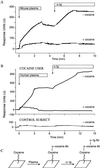Covalent modification of proteins by cocaine
- PMID: 11891282
- PMCID: PMC122537
- DOI: 10.1073/pnas.042700599
Covalent modification of proteins by cocaine
Abstract
Cocaine covalently modifies proteins through a reaction in which the methyl ester of cocaine acylates the epsilon-amino group of lysine residues. This reaction is highly specific in vitro, because no other amino acid reacts with cocaine, and only cocaine's methyl ester reacts with the lysine side chain. Covalently modified proteins were present in the plasma of rats and human subjects chronically exposed to cocaine. Modified endogenous proteins are immunogenic, and specific antibodies were elicited in mouse and detected in the plasma of human subjects. Covalent modification of proteins could explain cocaine's autoimmune effects and provide a new biochemical approach to cocaine's long-term actions.
Figures





Similar articles
-
Cocaine enhances monocyte migration across the blood-brain barrier. Cocaine's connection to AIDS dementia and vasculitis?Adv Exp Med Biol. 1998;437:199-205. doi: 10.1007/978-1-4615-5347-2_22. Adv Exp Med Biol. 1998. PMID: 9666272
-
Contribution of the active metabolite, norcocaine, to cocaine's effects after intravenous and oral administration in rats: pharmacodynamics.Psychopharmacology (Berl). 2001 Jan;153(3):341-52. doi: 10.1007/s002130000568. Psychopharmacology (Berl). 2001. PMID: 11271407
-
Cocaine-specific antibodies blunt the subjective effects of smoked cocaine in humans.Biol Psychiatry. 2010 Jan 1;67(1):59-65. doi: 10.1016/j.biopsych.2009.08.031. Biol Psychiatry. 2010. PMID: 19846066 Free PMC article. Clinical Trial.
-
Application of artificial enzymes to the problem of cocaine.Ann N Y Acad Sci. 2000;909:159-69. doi: 10.1111/j.1749-6632.2000.tb06681.x. Ann N Y Acad Sci. 2000. PMID: 10911929 Review.
-
Anticocaine catalytic antibodies.J Immunol Methods. 2002 Nov 1;269(1-2):299-310. doi: 10.1016/s0022-1759(02)00237-5. J Immunol Methods. 2002. PMID: 12379369 Review.
Cited by
-
Spontaneous development of IgM anti-cocaine antibodies in habitual cocaine users: effect on IgG antibody responses to a cocaine cholera toxin B conjugate vaccine.Am J Addict. 2013 Mar-Apr;22(2):169-74. doi: 10.1111/j.1521-0391.2013.00314.x. Epub 2013 Feb 1. Am J Addict. 2013. PMID: 23414504 Free PMC article. Clinical Trial.
-
Vaccines for cocaine abuse.Hum Vaccin. 2009 Apr;5(4):194-9. doi: 10.4161/hv.5.4.7457. Epub 2009 Apr 20. Hum Vaccin. 2009. PMID: 19276665 Free PMC article. Review.
-
Can you vaccinate against substance abuse?Expert Opin Biol Ther. 2013 Aug;13(8):1093-7. doi: 10.1517/14712598.2013.791278. Epub 2013 Apr 18. Expert Opin Biol Ther. 2013. PMID: 23594123 Free PMC article. Review.
-
Cocaine increases human immunodeficiency virus type 1 neuroinvasion through remodeling brain microvascular endothelial cells.J Neurovirol. 2005 Jul;11(3):281-91. doi: 10.1080/13550280590952835. J Neurovirol. 2005. PMID: 16036808
-
Systems-level view of cocaine addiction: the interconnection of the immune and nervous systems.Exp Biol Med (Maywood). 2014 Nov;239(11):1433-42. doi: 10.1177/1535370214537747. Epub 2014 Jun 5. Exp Biol Med (Maywood). 2014. PMID: 24903164 Free PMC article. Review.
References
-
- Chow M J, Ambre J J, Ruo T I, Atkinson A J, Bowsher D J, Fisherman M W. Clin Pharmacol Ther. 1985;38:318–324. - PubMed
-
- Isenschmid D S, Fischman M W, Foltin R W, Caplan Y H. J Anal Toxicol. 1992;16:311–314. - PubMed
-
- Volkow N D, Hitzemann R, Wang G J, Fowler J S, Wolf A P, Dewey S L, Handlesman L. Synapse. 1992;11:184–190. - PubMed
-
- Volkow N D, Wang G J, Fowler J S, Logan J, Gatley S J, Hitzemann R, Chen A D, Dewey S L, Pappas N. Nature (London) 1997;386:830–833. - PubMed
-
- Karoum F, Suddath R I, Wyatt R J. Eur J Pharmacol. 1990;186:1–8. - PubMed
Publication types
MeSH terms
Substances
LinkOut - more resources
Full Text Sources
Other Literature Sources

